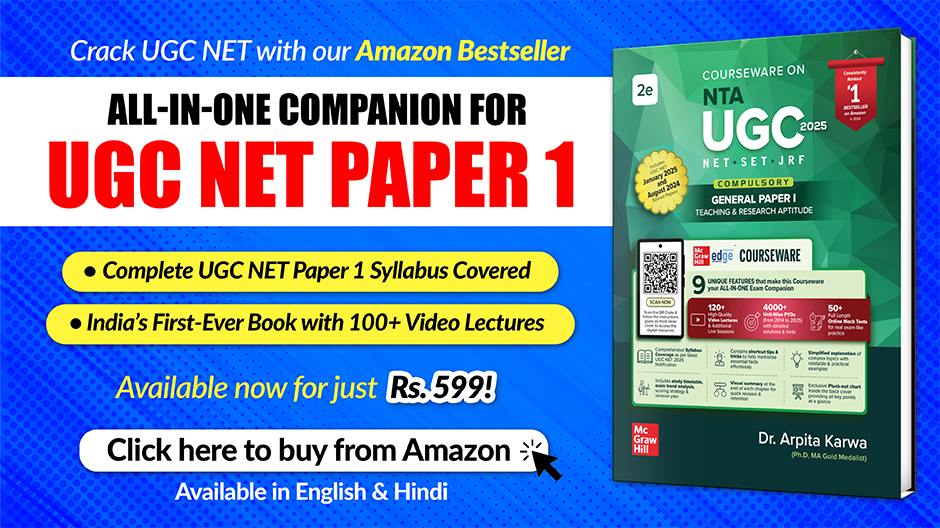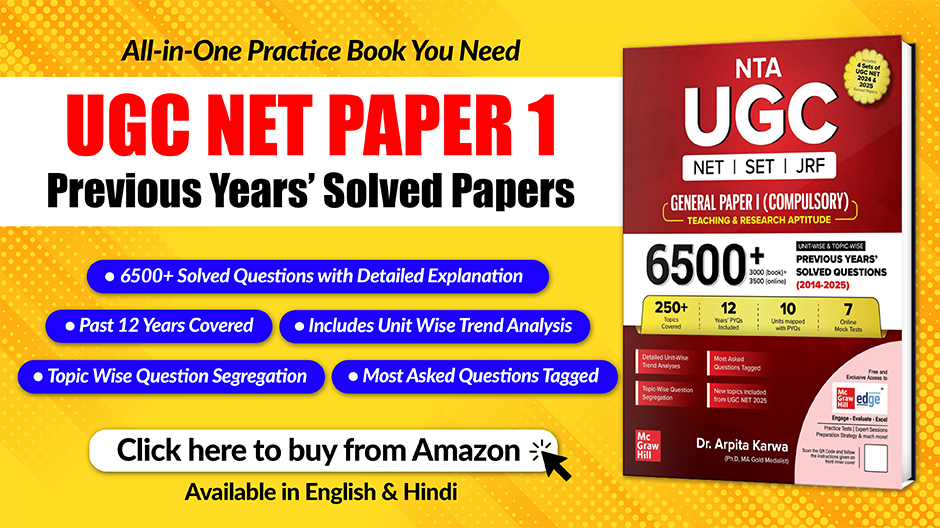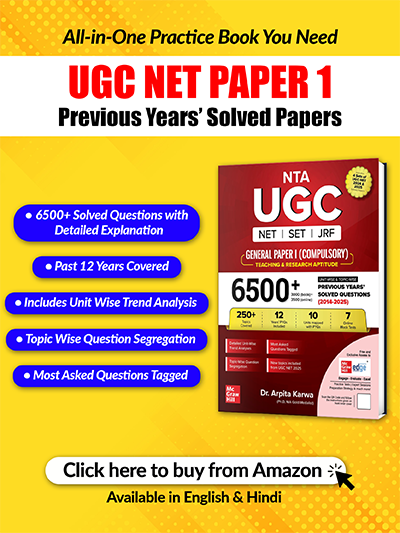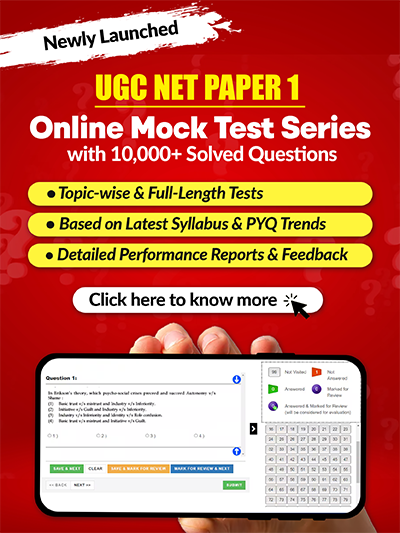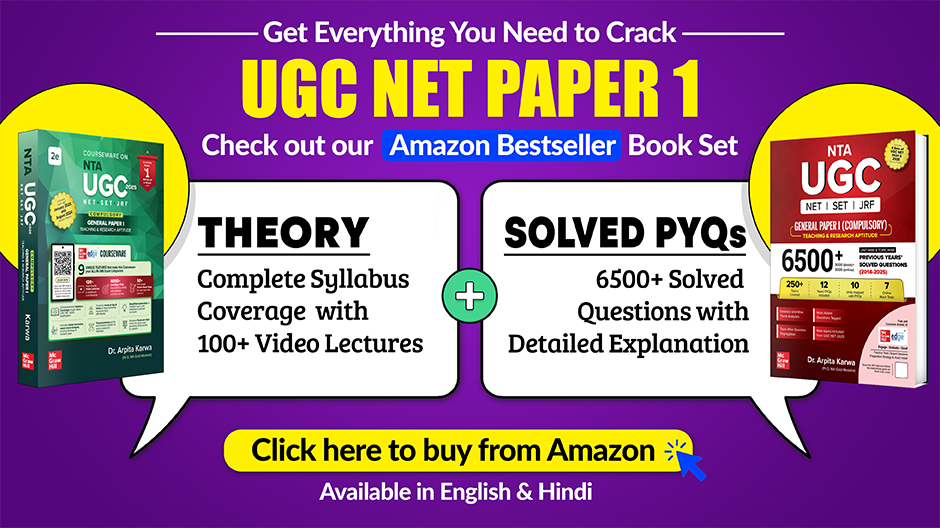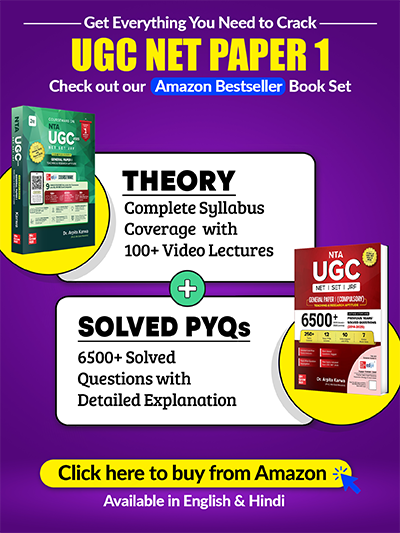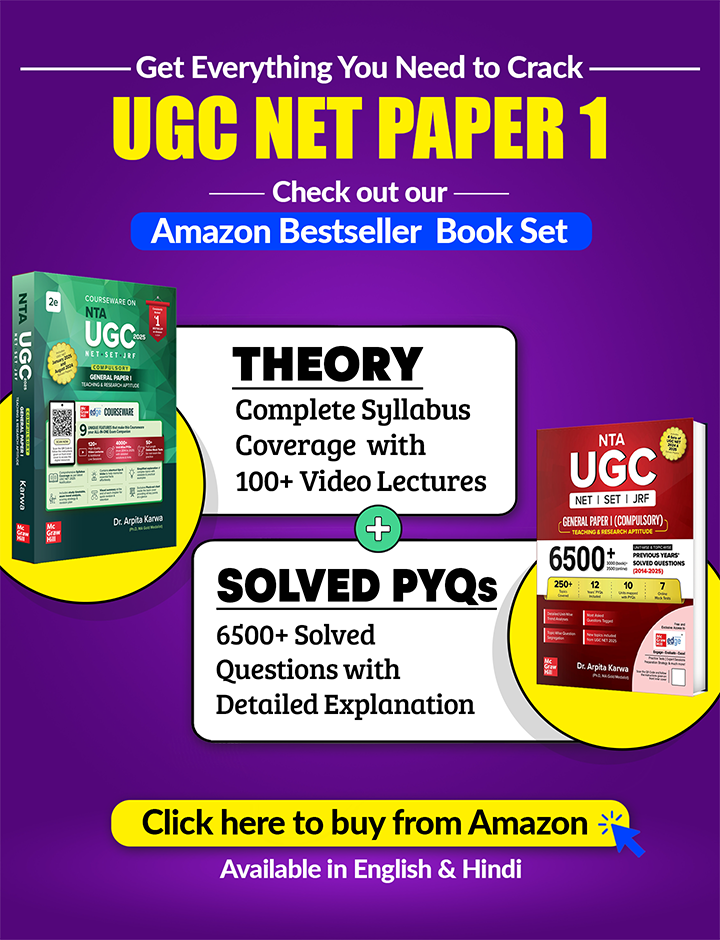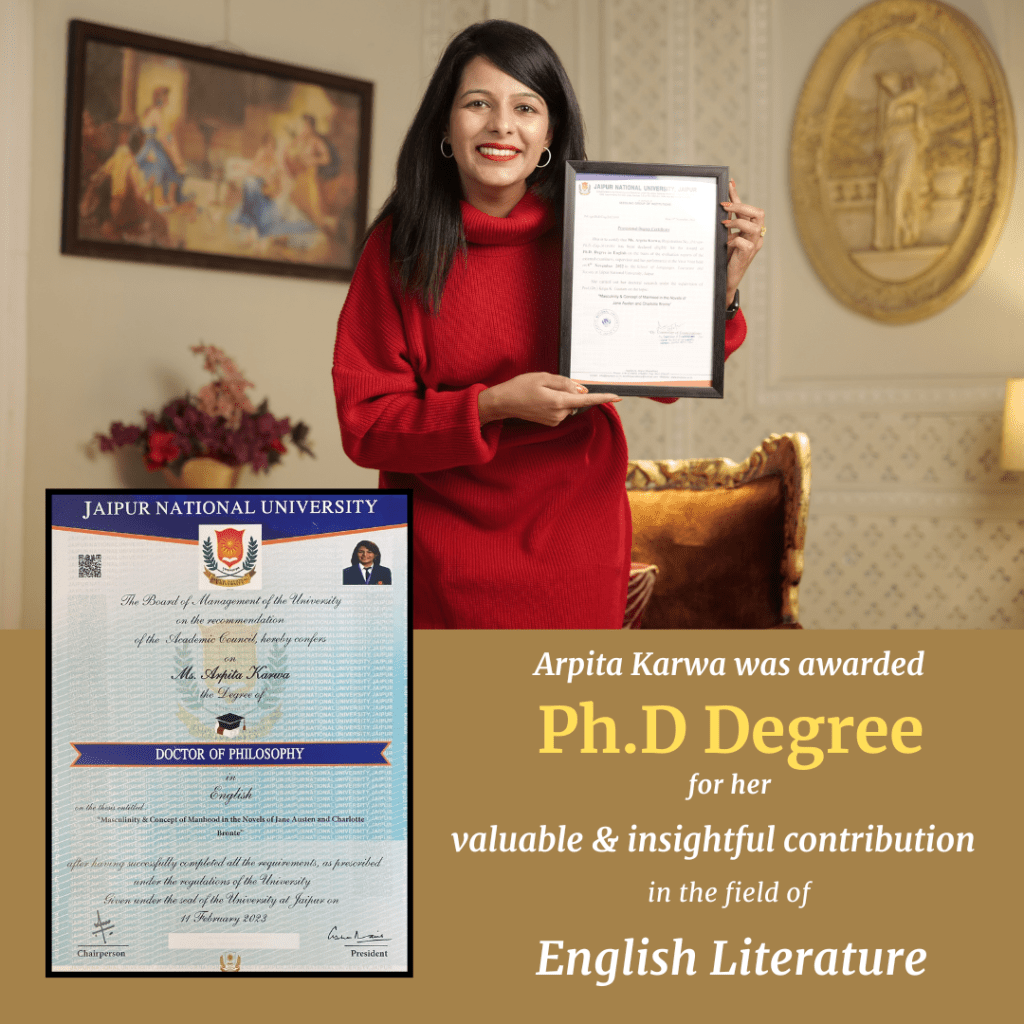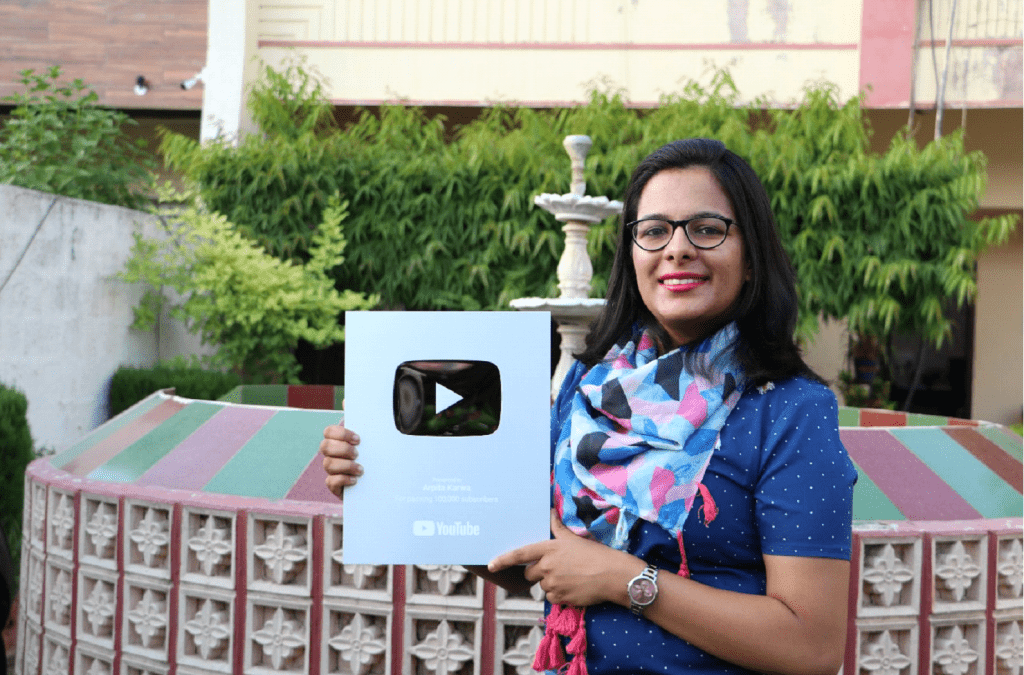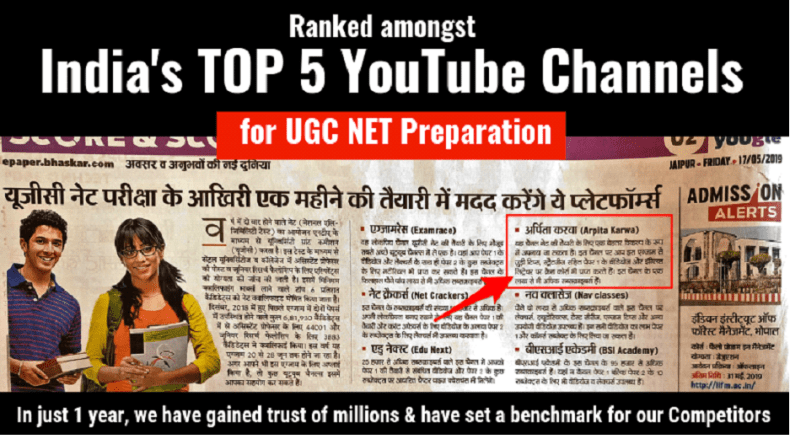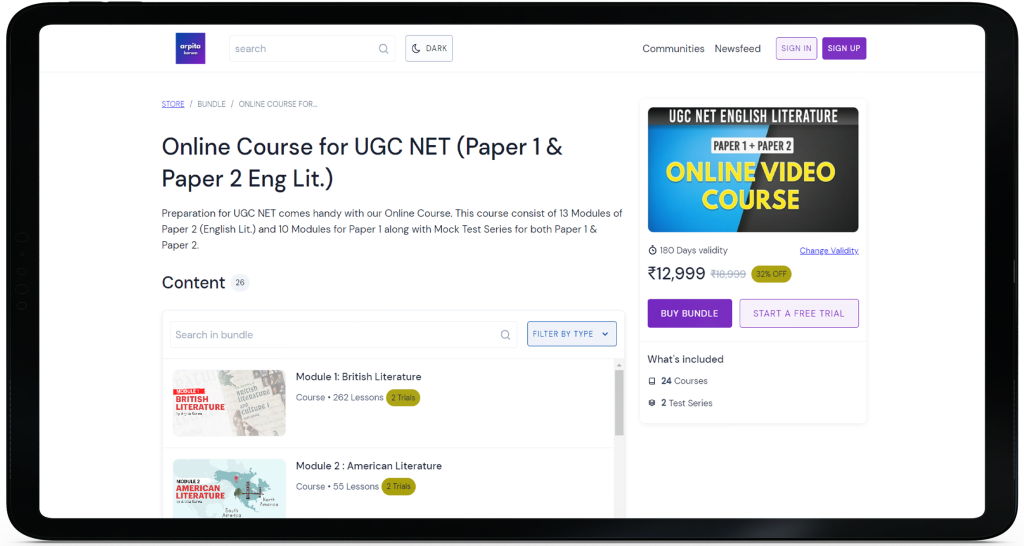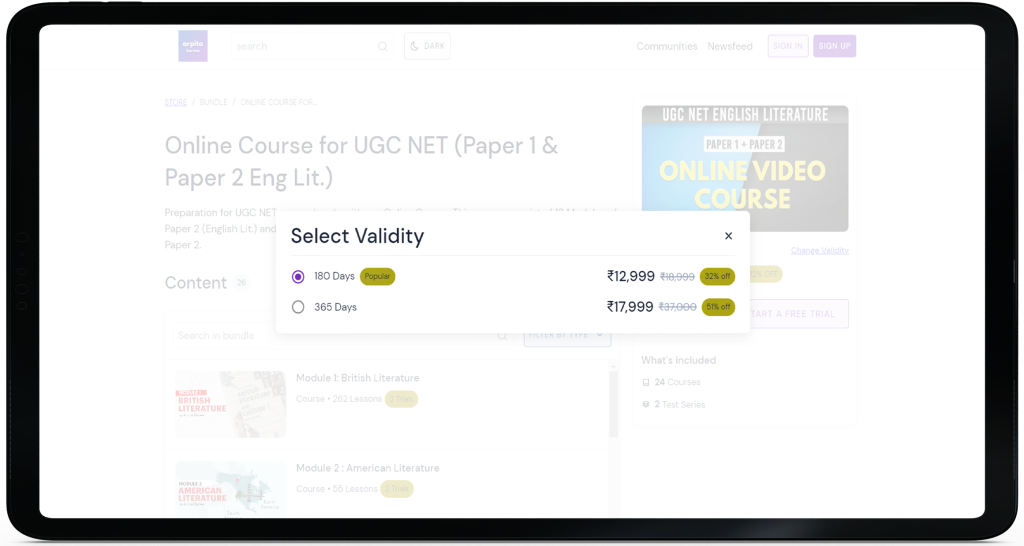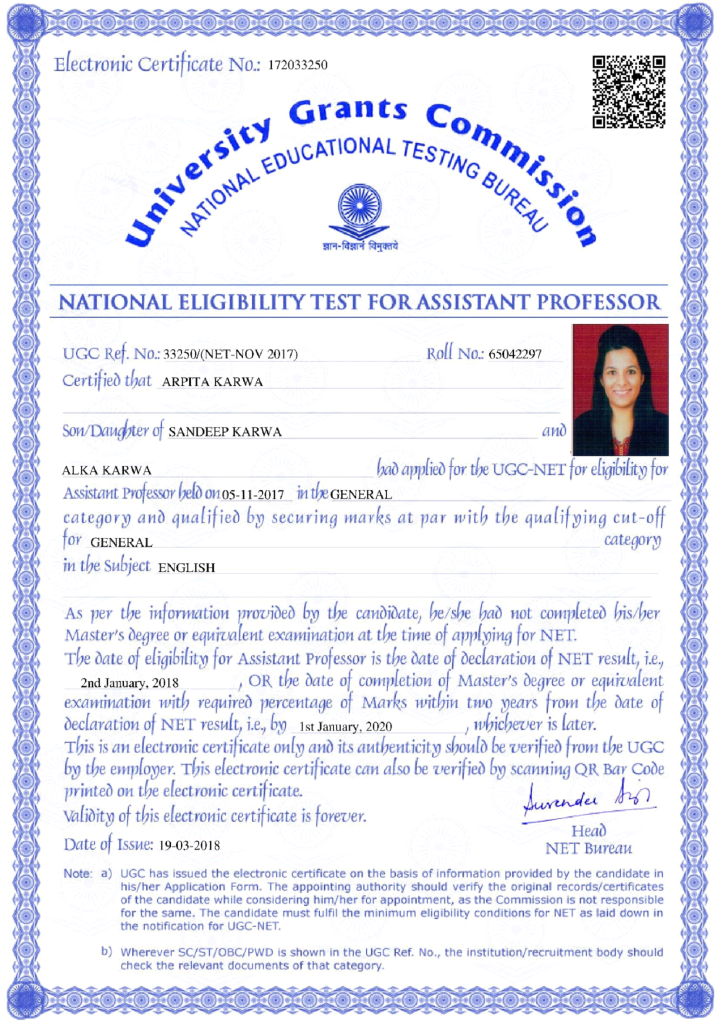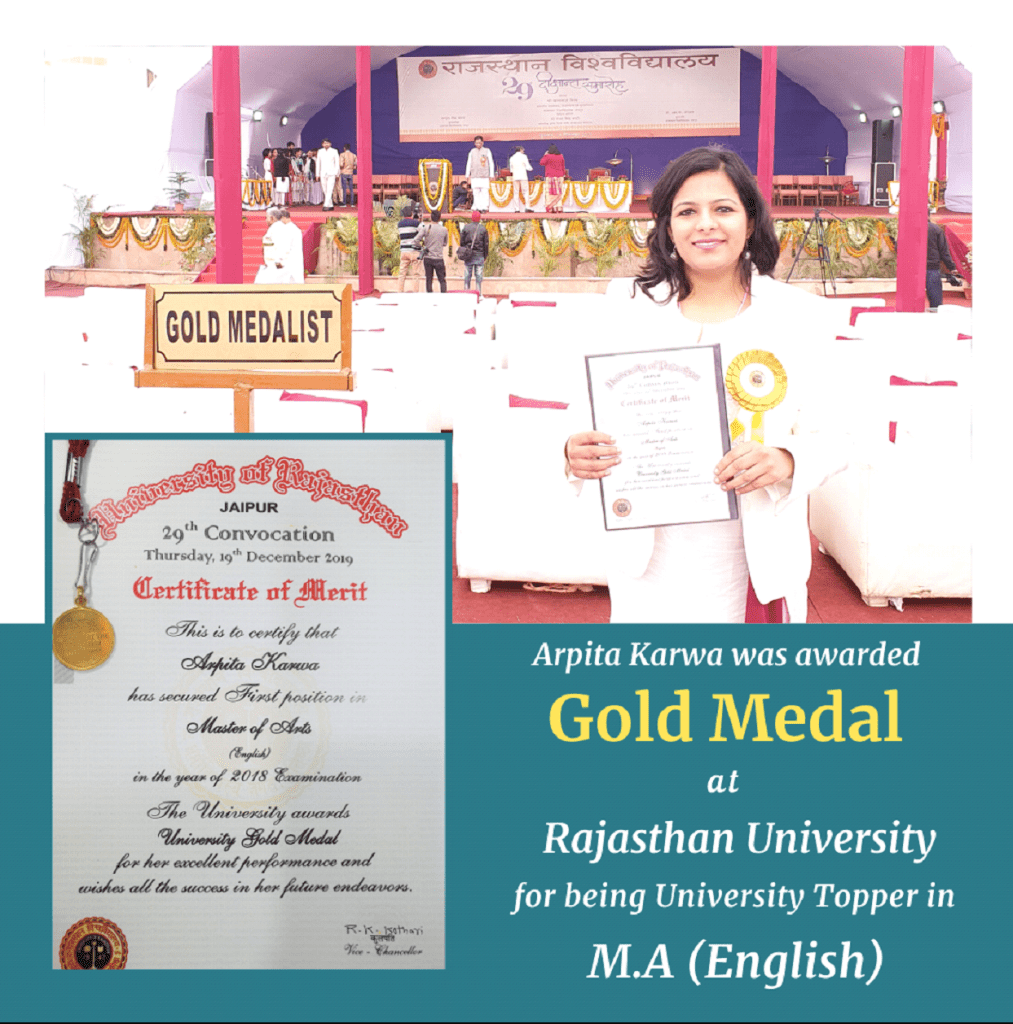January 2025 : Paper 2 (Conducted on 7th Jan 2025 : Evening Shift)
June 19, 2024 2025-10-13 15:02January 2025 : Paper 2 (Conducted on 7th Jan 2025 : Evening Shift)
January 2025 : Paper 2 (Conducted on 7th Jan 2025 : Evening Shift)
Q.1) Which of the following is not matched correctly?
[1] Ira De: The Hunt and Other Poems
[2] Margaret Chatterjee: The Spring and the Spectacle
[3] Tapati Mookerji: The Golden Road to Samerkhand
[4] Tilottama Ranjan: Poems of Govindagraj
Answer: 4
Q.2) ‘Who amongst the following was not a member of the Bloomsbury Group?
[1] Virginia Woolf
[2] E. M. Forster
[3] Lytton Strachey
[4] W. B. Yeats
Answer: 4
Q.3) Arrange the following texts in chronological order of their year of publication:
A. Coolie
B. The Big Heart
C. The Village
D. Two Leaves and a Bud
E. Seven Summers
[1] DCBAE
[2] EABCD
[3] ABCDE
[4] ADCBE
Answer: 4
Q.4) Functional Communicative Approach in English Language Teaching is in opposition to the:
[1] Comprehensive Approach
[2] Grammar Translation Method
[3] Functional Approach
[4] Structural Approach
Answer: 4
Q.5) Arrange the following steps of ‘Decision making’ in the research process:
A. The choice of a research topic or theme.
B. Data collection
C. Analysis and interpretation of data.
D. Formulating the research problem.
E. Conceptualization and operationalization.
[1] ABDCB
[2] ABCDE
[3] DCABE
[4] ADEBC
Answer: 4
Q.6) Which among the following does not fall in the category of a Revenge Tragedy?
[1] The Spanish Tragedy
[2] The Jew of Malta
[3] Hamlet
[4] Cymbeline
Answer: 4
Q.7) Match the column:
A. Basudev Sunani
B. Om Prakash Valmiki
C. Bama
D. Urmila Pawar
I. Karukku
II. Weave of My Life
III. Cast Out
IV. Joothan
[1] A-III, B-I, C-II, D-IV
[2] A-III, B-IV, C-I, D-II
[3] A-IV, B-I, C-II, D-III
[4] A-I, B-II, C-III, D-IV
Answer: 2
Q.8) Which of the given statements are correct?
A. Omprakash Valmiki’s Joothan is a novel.
B. Joothan represents the Dalit Valmiki community in critical light.
C. Joothan enumerates the difficulties of being a Dalit in independent India.
D. Joothan was translated into English by Arun Prabha Das.
E. Joothan critiques the upper castes.
[1] ABC
[2] BDE
[3] BCE
[4] CDE
Answer: 3
Q.9) From the statements given below, what is true about the Gothic Novel?
A. It appeared in 14th Century American Literature.
B. It often uses the medieval form of architecture as setting.
C. It is a form of baroque art.
D. It represents a style of mosaic and fresco wall painting.
E. It aims at evoking chilling terror by exploiting mystery and a variety of horrors.
[1] AD
[2] CE
[3] BD
[4] BE
Answer: 4
Q.10) What is ‘Practical Criticism’?
[1] The close analysis of literary texts in such a way as to bring out their political meaning.
[2] A movement which wished to make literary criticism more relevant.
[3] The close analysis of poems without taking account of any external information.
[4] The study of ambiguity.
Answer: 3
Q.11) “There is nothing outside the text” is a statement by:
[1] Victor Shklovsky
[2] Jacques Derrida
[3] Roland Barthes
[4] Ferdinand de Saussure
Answer: 2
Q.12) Who has written The Life Divine ?
[1] Dante
[2] Emerson
[3] Sri Aurobindo
[4] Jayant Mahapatra
Answer: 3
Q.13) Identify the ones which are matched correctly.
A. Barbara Christian : “The Race for Theory”
B. Alfred W. Crosby : “Unhiding the Hidden”
C. Paul Carter : “Naming Place”
D. Graham Huggan: “Ecological Imperialism”
E. Thomas B Macaulay : “Minutes on Indian Education”
[1] A and B only
[2] A, C and E only
[3] C and D only
[4] D and E only
Answer: 2
Q.14) The line “Thou still unravished bride of quietness™ presents which of the following rhetorical figures?
[1] Anastrophe
[2] Apostrophe
[3] Anaphora
[4] Chiasmus
Answer: 2
Q.15) Identify the correct statements concerning the respective genre:
A. An epistle is a literary genre in the form of letter.
B. Epigraph is an inscription on funeral monument.
C. Epigram is a short, pithy poem wittily expressed.
D. Epitaph is a formal statement in the beginning of a literary work
E. Epyllion is a short poem in the meter of an epic poetry.
[1] A, B and C only
[2] B, D and A only
[3] A, C and E only
[4] D, C and E only
Answer: 3
Q.16) Match the column:
(Texts)
A. Bodies that Matter
B. A World of Difference
C. A Literature of their Own
D. Vamps and Tramps
(Author)
I. Barbara Johnson
II. Judith Butler
III. Camille Paglia
IV. Elaine Showalter
[1] A-I B-II, C-III, D-IV
[2] III, B-II, C-I, D-IV
[3] A-II, B-I, C-IV, D-III
[4] A-IV, B-III, C-II, D-I
Answer: 3
Q.17) Which among the following novels is not written by Mary Shelley?
[1] The Lost Woman
[2] Frankenstein
[3] Falkner
[4] The Last Man
Answer: 1
Q.18) Chronologically arrange the following works according to the year of publication.
A. Gauri Viswanathan’s Masks of Conquests.
B. Meenakshi Mukherjee’s The Twice Born Fiction.
C. G. N. Devy’s After Amnesia
D. M. K. Naik’s 4 History of Indian English Literature
E. Harish Trivedi’s Colonial Transactions
[1] ABCDE
[2] EDCBA
[3] CADBA
[4] BDACE
Answer: 4
Q.19) Identify the one who was not a ‘New Critic’:
[1] Allen Tate
[2] Robert Penn Warren
[3] Cleanth Brooks
[4] Claude Levi-Strauss
Answer: 4
Q.20) Who among the following is credited with ending the system of patronage with his “Letter to Lord Chesterfield”?
[1] Bishop Berkeley
[2] Samuel Johnson
[3] Edmund Burke
[4] Horace Walpole
Answer: 2
Q.21) Who among the following illustrated the works of Thomas Gray and Robert Blair?
[1] Thomas Percy
[2] William Blake
[3] Robert Burns
[4] William Cowper
Answer: 2
Q.22) Arrange the following works of literature chronologically based on their year of publication:
A. The English Patient
B. The Swinging Bridge
C. Lives of Girls and Women
D. Family Matters
E. Birnam Wood
[1] DBACE
[2] BADCE
[3] CBDAE
[4] CADBE
Answer: 4
Q.23) Which of the following works of R. K. Narayan were published after independence?
A. The Dark Room
B. The English Teacher
C. The Financial Expert
D. Swami and Friends
E. The Guide
[1] AB
[2] BD
[3] CE
[4] AD
Answer: 3
Q.24) Match the column:
(Poet)
A. Edmund Spenser
B. Philip Sidney
C. Thomas Wyatt
D. Henry Howard, Ear of Surrey
(poem)
I. “Whose List to Hunt”
II. “So Cruet Prison how could Betide”
III. “The Faerie Queene”
IV. “The Defense of Poesy”
[1] A-IV B-II C-I D-III
[2] A-III B-IV C-I D-II
[3] A-I B-III C-IV D-II
[4] A-II B-IV C-III D-IV
Answer: 2
Q.25) Match the column:
(Novel)
A. The Childhood of Jesus
B. The Go-Between
C. Brideshead Revisited
D. The Catcher in the Rye
(Novelist)
I. L. P. Hartley
II. Evelyn Waugh
III. J. M. Coetzee
IV. J. D. Salinger
[1] A-I, B-IV, C-III, D-II
[2] A-III, B-1, C-II, D-IV
[3] A-I, B-II, C-1, D-III
[4] A-I, B-III, C-IV, D-I
Answer: 2
Q.26) The Grammar Translation Method in English Language Teaching stresses on:
[1] Fluency
[2] Accuracy
[3] Appropriateness
[4] Listening Skill
Answer: 2
Q.27) Identify the correct statement on about ‘Langue’ and ‘Parole’ below:
A. Langue is the abstract language system, the grammar of a language.
B. Parole is the language actually produced by its users following Langue.
C. Langue is the language actually produced by its users following Parole.
D. Parole is the abstract language system, the grammar of a system.
E. Langue and Parole are not related to one language as concepts.
[1] AB
[2] AC
[3] BC
[4] DE
Answer: 1
Q.28) In which of the texts, the following lines occur?
“Of all the causes which conspire to blind
Man’s erring judgement, and misguide the mind,
What the weak head with strongest bias rules,
Is pride, the never failing vice of fools.”
[1] An Essay on Criticism
[2] The Rape of the Lock
[3] 4n Essay on Man
[4] Epistle to Dr. Arbuthnot
Answer: 1
Q.29) Match the column:
A. Defamiliarization
B. Uncanny
C. Actor Network Theory
D. Homo Sacer
I. Girgio
II. Bruno Latour
III. Viktor Shlovsky
IV. Sigmund Freud
[1] A-II, B-IV, C-III, D-I
[2] A-IV, B-I, C-II, D-III
[3] A-III, B-II, C-I, D-IV
[4] A-III B-IV, C-II, D-I
Answer: 4
Q.30) Match the column:
(Author)
A. Paul Ehrlich
B. Lawrence Buell
C. Nevil Shute
D. Rachel Carson
(Text)
I. The Environmental Imagination (1995)
II. On the Beach (1957)
III. Silent Spring (1962)
IV. The Population Bomb (1972)
[1] A-II, B-III, C-IV, D-I
[2] A-IV, B-I, C-II, D-III
[3] A-I, B-II, C-III, D-IV
[4] A-III, B-II, C-I, D-IV
Answer: 2
Q.31)
LIST I LIST-II
(Text)
A. Autobiography of an Unknown Indian
B. My Son’s Father
C. All through the Gandhian Era
D. My God Died Young
(Author)
I. Dom Moraes
II. A.S. Iyenger
III. Sasthi Brata
IV. Nirad C. Chaudhary
[1] A-I, B-II, C-III, D-IV
[2] A-III, B-II, C-I, D-IV
[3] A-IV, B-I, C-II, D-III
[4] A-II, B-III, C-IV, D-I
Answer: 3
Q.32) Match the column:
A. Nala and Damayanti
B. Jayadeva
C. The Viziers of Bassora
D. The Flute of Krishna
I. Sri Aurobindo
II. Vasudeva Rao
III. P.A. Krishnaswamy
IV. Harindranath
[1] A-III, B-II, C-IV, D-I
[2] A-II, B-IV, C-I, D-III
[3] A-IV, B-III, C-II, D-I
[4] A-II, B-I, C-III, D-IV
Answer: 2
Q.33) Which of the following novels deal with the theme of apartheid?
A. Purple Hibiscus
B. July’s People
C. Cry, the Beloved Country
D. The Mimic Men
E. My Son’s Story
[1] CE
[2] ACD
[3] BCE
[4] AB
Answer: 3
Q.34) Which of the following is not correctly matched?
[1] Seamus Heaney : “Digging”
[2] Audre Lorde : “Coal”
[3] Dom Moraes : “Kanheri Caves”
[4] John Updike : “The Swan”
Answer: 4
Q.35) Which of the following is an elegy on John Donne’s wife who died in 1617?
[1] “Death be not Proud”
[2] “Thou Hast Made Me”
[3] “Holy Sonnet 17″
[4] “At the Round Earth’s Imagined Corners”
Answer: 3
Q.36) Arrange the following in the chronological order of their year of publication.
A. Deconstruction and Criticism
B. Multiculturalism: Roots and Realities
C. Literary Theory and the Claims of History
D. The Western Canon
E. An Appetite for Poetry
[1] DCEBA
[2] AEDCB
[3] ABCDE
[4] CDBAE
Answer: 2
Q.37) Which of the following novelists did not employ “Stream of Consciousness” technique?
[1] Virginia Wolf
[2] James Joyce
[3] Dorothy Richardson
[4] Graham Greene
Answer: 4
Q.38) Arrange the following works of Francis Bacon in the chronological order of their year of publication:
A. Advancement of Learning
B. De Augmentis Scientiarum
C. Novum Organum
D. The New Atlantis
E. History of Henry VII
[1] ACEBD
[2] CABED
[3] ABEDC
[4] EDCAB
Answer: 1
Q.39) The author of “The Politics of Translation” and translator of Mahashweta Devi’s “Standayini” is:
[1] Homi Bhabha
[2] Jhumpa Lahiri
[3] Gayatri C. Spivak
[4] Tejaswini Niranjana
Answer: 3
Q.40) Which of the following statements are true about Modernism?
A. Modernism marked a break with formal conventions
B. Old ways of thought underwent cultural shift
C. Decline of liberal humanism
D. Modernism revived classical scholarship
E. Modernism promoted logocentric way of thoughts
[1] CDE
[2] BCD
[3] ABC
[4] ADE
Answer: 3
Q.41) Langston Hughes’ poem “I too Sing America” is a response to which of the following poets?
[1] Herman Melville
[2] Walt Whitman
[3] Henry David Thoreau
[4] Emily Dickinson
Answer: 2
Q.42) Choose the correct sequence of the following works of Pablo Neruda in chronological order:-
A. Spain in the Heart
B. Works and Book of Turlights
C. The Inhabitant and His Hope
D. Tiventy Love Poems and a Song of Despair
E. The Trying of Infinite Man
[1] ECDBA
[2] ABCDE
[3] EDBCA
[4] BDECA
Answer: 4
Q.43) Arrange the following poems by W. B. Yeats in the chronological order of their year of publication:
A. “Adam’s Curse”
B. “Among School Children”
C. “The Second Coming”
D. “The Wild Swans at Coole”
E. “Under Ben Bulben”
[1] ABCDE
[2] CDBAE
[3] EBDCA
[4] ADCBE
Answer: 4
Q.44) Match the column:
(Author)
A. Manohar Malgaonkar
B. Chaman Nahal
C. Ruskin Bond
D. Arun Joshi
(Text)
I. The Weird Dance and Other Stories
II. The Survivor
III. Rumble Tumble
IV. Neighbour’s Wife and Other Stories
[1] A-III, B-I, C-IV, D-II
[2] A-I, B-II, C-III, D-IV
[3] A-III, B-II, C-I, D-IV
[4] A-II, B-III, C-IV, D-I
Answer: 1
Q.45) “Success is counted sweetest
By those who ne’er succeed.
To comprehend a nectar
Requires sorest need.”
Who has composed the above lines?
[1] Christiana Rossetti
[2] Thomas Hardy
[3] Emily Dickinson
[4] Mathew Arnold
Answer: 3
Q.46) Which of the statements given below are true?
A. The centre for contemporary Cultural Studies was established in Berkley in 1960.
B. Jurgen Habermas traces the rise of the public sphere to the rise of print culture.
C. Paul Gilroy introduced the concept of the Black Atlantic.
D. Adorno praises the alien nature of avant-garde modernist art such as the atonal music of Schoenberg.
E. Chutnification was a term used by Edward Soja.
[1] ABC
[2] BCD
[3] CDE
[4] ABD
Answer: 2
Q.47) When was ‘International Phonetic Alphabet’ (IPA) developed and promulgated?
[1] 1868
[2] 1878
[3] 1888
[4] 1978
Answer: 3
Q.48) Which of the following statements are true about A. K. Ramanujan?
A. He is a poet of the sixties.
B. His poetry draws his sustenance from his awareness of Hindu heritage.
C. He has poor sense of rhythm.
D. His verse poorly utilises Akam constructed techniques.
E. He utilises Akam constructed techniques in his poetry.
[1] C, D and E only
[2] A, B and E only
[3] B, C and D only
[4] B, D and E only
Answer: 2
Q.49) Arrange the following novels of D. H. Lawrence in chronological order of their year of publication:-
A. Women in Love
B. The White Peacock
C. Sons and Lovers
D. The Rainbow
E. The Trespasser
[1] ABCDE
[2] ECDAB
[3] BECDA
[4] CAEDB
Answer: 3
Q.50) Identify the correct options from the following statements:
A. Ecocriticism has often explained the ‘human and non-human webs of interrelation.”
B. In Ecocriticism, human accountability to the environment is part of the text’s ethical orientation.
C. Ecocriticism foregrounds the notion of an interplay between environment and the body.
D. There is only one wave of Ecocriticism.
E. Ecocriticism has not tackled the issue of gender.
[1] A, B, C only
[2] B,C,D only
[3] A,C,D only
[4] A,B,D, E only
Answer: 1
Q.51) In which year was Raja Rao’s Kanthapura published?
[1] 1938
[2] 1960
[3] 1965
[4] 1947
Answer: 1
Q.52) Identify all the Australian Aboriginal writers out of the following:
A. Kim Scott
B. Peter Carey
C. Oodgeroo Noonuccal
D. Kevin Gilbert
E. Derek Walcott
[1] B, C and D only
[2] C, D and E only
[3] A, C and D only
[4] B, A and E only
Answer: 3
Q.53) Which of the following is a Dramatic Monologue?
[1] “The Cannonization”
[2] “Tintern Abbey”
[3] “Andrea de Sarto”
[4] “The Flea”
Answer: 3
Q.54) Which of the following texts has been written by Rabindranath Tagore?
[1] Tiger-Claw
[2] Chandalika
[3] A Touch of Brightness
[4] Image Breakers
Answer: 2
Q.55) Match the column:
A. The Golden Light
B. The Lotus
C. Indian Dancers
D. The Harp of India
I. Toru Dutt
II. Sarojini Naidu
III. Hency Derozio
IV. Sri Aurobindo
[1] A-IV, B-II, C-I, D-III
[2] A-IV, B-III, C-II, D-I
[3] A-IV, B-II, C-III, D-I
[4] A-IV, B-I, C-II, D-III
Answer: 4
Q.56) Arrange the following works in the chronological order of their year of publication:
A. S. Menon Marath’s The Wound of Spring
B. Humayun Kabir’s Men and Rivers
C. Anand Lall’s The House at Adampur
D. Sudhindra N. Ghose’s The Vermillion Boat
E. Ved Mehta’s Delinquent Chacha
[1] EDCBA
[2] BDCAE
[3] ABCDE
[4] DCBAE
Answer: 2
Q.57) The first folio of Shakespeare’s plays appeared in:
[1] 1664
[2] 1650
[3] 1631
[4] 1623
Answer: 4
Q.58) Who is the best known figure amongst the following for articulating the concept of ‘Negritude’?
[1] Edward Said
[2] Aime Cesaire
[3] William Jones
[4] Anna Rutherford
Answer: 2
Q.59) Which of the following poems uses ‘terza rima’?
[1] John Keats’ “Ode to Nightingale”
[2] P. B. Shelley’s “Ode to the West Wind”
[3] William Worlsworth’s “The Solitary Reaper”
[4] Alfred Tennyson’s “Ulysses”
Answer: 2
Q.60) From which poem are the following lines extracted?
“Once more the storm is hauling and half hid
Under this cradle-hood and coverlid,
My child sleeps on. There is no obstacle.
But Gregory’s wood and one bare hill.”
[1] “The Second Coming”
[2] “The Cold Heaven”
[3] “A Prayer for My Daughter”
[4] “Among School Children”
Answer: 3
Q.61) Which among the following is the last novel of George Eliot?
[1] Middlemarch
[2] Daniel Deronda
[3] Silas Marner
[4] The Mill on the Floss
Answer: 2
Q.62) The famous short poem “Elegy on the Death of a Mad Dog” appears in which one of the following Eighteenth Century novels?
[1] Roderick Random by Tobias Smollet
[2] Tristram Shandy by Lawrence Sterne
[3] The Vicar of Wakefield by Oliver Goldsmith
[4] The Castle of Otranto by Horace Walpole
Answer: 3
Q.63) Which of the following is not an autobiography?
[1] Patrick White: A Life
[2] Long Walk to Freedom
[3] My Experiments with Truth
[4] Akkarmashi (The Outcaste)
Answer: 1
Q.64) Arrange the following works in the chronological sequence of their year of publication:
A. Mathews Arnold’s Culture and Anarchy
B. Thomas Browne’s The Anatomy of Melancholy
C. P. B. Shelley’s Defence of Poetry
D. Thomas Hobbes’ Leviathan
E. Walter Pater’s Studies in the History of the Renaissance
[1] ABCDE
[2] DCBAE
[3] BCEAD
[4] BDCAE
Answer: 4
Q.65) What does deductive method of reasoning refer to?
[1] From general to particular
[2] From particular to general
[3] From linear to circular
[4] From circular to linear
Answer: 1
Q.66) Arrange the following in the chronological order of their year of publication:
A. “The Tyger”
B. “The Solitary Reaper”
C. “Adonais”
D. “The Rime of the Ancient Mariner”
E. “Ode to Autumn”
[1] B,C,D,E,A
[2] C,D,E,A,B
[3] A,D,B,E,C
[4] D,A,E,B,C
Answer: 3
Q.67) Which of the following is not a character in William Congreve’s The Way of the World?
[1] Fainall
[2] Mirabell
[3] Waitwell
[4] Peachum
Answer: 4
Q.68) “O Sir, content you’,
I follow him to serve my turn upon him.
We cannot all be masters, nor all masters cannot be truly followed.”
The above lines were spoken by which of the following characters?
[1] Roderigo
[2] Iago
[3] Caliban
[4] Cassio
Answer: 2
Q.69) Arrange the following in chronological order of their year of publication:
A. Fraser’s Magazine
B. The Spectator
C. The Westminster Review
D. The Quarterly Review
E. Edinburg Review
[1] ABCDE
[2] CDEAB
[3] EDCBA
[4] DCABE
Answer: 3
Q.70) Match the column:
A. My Days with Gandhi
B. Among the Great
C. Life of Sri Aurobindo
D. Rabindranath Tagore
I. D.K. Roy
II. N.K. Basu
III. Krishna Kripalani
IV. A.B. Purani
[1] A-I, B-II, C-III, D-IV
[2] A-III, B-II, C-I, D-IV
[3] A-IV, B-III, C-II, D-I
[4] A-II, B-I, C-IV, D-III
Answer: 4
Q.71) Match the column:
(Term)
A. Antonomasia
B. Antiphrasis
C. Apocrypha
D. Aretalogy
(Meaning)
I. Writings or statements of doubtful or spurious authorship.
II. A figure of speech in which some defining word or phrase is substituted for a person’s proper name.
III. A narrative of miraculous deeds of God or Hero.
IV. Ironic or humorous use of words in senses opposite to the generally accepted meanings.
[1] A-II, B-IV, C-I, D-III
[2] A-IV, B-II, C-III, D-I
[3] A-I, B-II, C-IV, D-III
[4] A-II, B-I, C-IV, D-III
Answer: 1
Q.72) Which of the following are correct according to the MLA Handbook, 9th edition?
A. One inch margin on all sides is compulsory in a research page.
B. Co-ordinating conjunctions are written in bold letters in the title of a research paper.
C. Slash is used between two nouns paired as opposites.
D. Hanging indent” in the work cited entry is % inches
E. Subordinating conjunctions are not written in bold letters in the title of the research paper.
[1] A, C and D only
[2] B, D and A only
[3] C, D and E only
[4] B, C and E only
Answer: 1
Q.73) Identify the statements which are true for Psychoanalytic Criticism.
A. The premises and procedures were established by Sigmund Freud.
B. Freud posited that artists are like neurotic patients.
C. Freud posited that ‘Psychoanalysis’ can be used to account for many developments and practices in the history of civilization.
D. A repressed wish does not become fantasy.
E. Freud proposed that literature and other arts manifest the repressed subconscious and unconscious drives of the artist.
[1] ABD
[2] ABC
[3] BAD
[4] ACE
Answer: 4
Q.74) Which of the following statements are correct about ‘Litotes’?
A. It contains an understatement for emphasis.
B. It is not opposite of hyperbole.
C. It is used with laconic intentions.
D. It is used with ironic intentions.
E. It is used in dramatic context.
[1] BCD
[2] CDE
[3] ADE
[4] ACD
Answer: 4
Q.75) Who is the author of English in India : Its Present and Future published in 1964?
[1] G. T. Garratt
[2] Rameshwar Gupta
[3] V.K. Gokak
[4] A.R. Chide
Answer: 3
Q.76) Shakespeare’s Much Ado About Nothing is a:
[1] Tragi Comedy
[2] Romantic Comedy
[3] Pastoral Play
[4] History Play
Answer: 2
Q.77) An ideal research paper should include:
A. A statement that establishes the problem or controversial issue that the paper intends to examine.
B. Background information to establish past theories and current ideas on the topic.
C. Summarizing and paraphrasing.
D. Glorification of the paper writer himself.
E. A thesis to establish one’s position.
[1] A, C and D only
[2] A and D only
[3] C and D only
[4] A, B and E only
Answer: 4
Q.78) Who said “The introduction of foreigners does not necessarily destroy the nation, they merge in it”?
[1] Frantz Fanon
[2] Leopold Senghor
[3] Sri Aurobindo
[4] M. K. Gandhi
Answer: 4
Q.79) The incorrect works cited entries according to MLA Handbook, 9th edition are:
A. Jacobs, Alan. The Pleasures of Reading in the Age of Destruction. Oxford UP, 2011.
B. Charon, Rita, et al. The Principles and Practice of Narrative Medicine. Oxford UP, London, 2017.
C. Sabau, Ana. “The Perils of Ownership™. American Review, vol.10, no.2, 2007, pp.1-27.
D. Riddle, Julie. “Shadow Animals.” The Georgia Review, 67.3, pp. 424-47.
E. Copeland, Edward. The Cambridge Companion to Jane Austin. Cambridge UP, 1997. 131-48.
[1] A, B and C only
[2] B, C and D only
[3] B, D and E only
[4] D, E and A only
Answer: 3
Q.80) Identify the poet who has composed the following lines:
“Ganga was sunken, and the limp leaves
Waited for rain, while the black clouds
Gathered far distant, over Himavant.
The Jungle crouched, humped in silence.”
[1] Ralph Waldo Emerson
[2] T. S. Eliot
[3] Emily Dickinson
[4] Sri Aurobindo’
Answer: 2
Q.81) Match the column:
A. Henry Miller
B. John Steinbeck
C. James Jones
D. James Baldwin
I. The Grapes of Wrath
II. No Name in the Streets
III. Tropic of Cancer
IV. From Here to Eternity
[1] A-I, B-II, C-II, D-IV
[2] A-III, B-I, C-IV, D-II
[3] A-IV, B-II, C-I, D-III
[4] A-III, B-II, C-IV, D-I
Answer: 2
Q.82) Which of the following options are true about the epistemological dimension of research?
A. Scientific realism
B. The search for truth
C. Critical theory
D. Certain and indubitable knowledge
E. Mechanism of social control
[1] A and C only
[2] B and D only
[3] D and A only
[4] C, D and E only
Answer: 2
Q.83) ‘Who among the following has written the poem, “Jejuri” ?
[1] Michael Madhusudan Dutt
[2] Kamla Das
[3] Arun Kolatkar
[4] Toru Dutt
Answer: 3
Q.84) Match the column:
A. Mikhail Bakhtin
B. Michael Foucault
C. Roland Barthes
D. Sigmund Freud
I. Archeology of the Human Sciences
II. Text can be either readerly or writerly
III. Dialogue as the intrinsic feature of language
IV. Dreams end the unconscious
[1] A-I, B-II, C-III, D-IV
[2] A-III, B-II, C-IV, D-I
[3] A-II, B-I, C-II, D-IV
[4] A-IV, B-II, C-III D-I
Answer: 3
Q.85) Arrange the plays of William Shakespeare in the chronological order of their year of publication:
A. The Tempest
B. Love’s Labour Lost
C. Twelfth Night
D. Much Ado About Nothing
E. A Midsummer Night’s Dream
[1] BEDCA
[2] EADCB
[3] ABCDE
[4] ACDBE
Answer: 1
Q.86) Match the column;
(Author)
A. Kamala Markandeya
B. P. Sivakami
C. Anita Desai
D. Raj Lakshmi Debi
(Text)
I. The Grip of Change
II. The Enchanted Fruit
III. Possession
IV. Cry, the Peacock
[1] A-III, B-I, C-IV, D-II
[2] A-I, B-II, C-III, D-IV
[3] A-IV, B-II, C-III, D-I
[4] A-II, B-III, C-I, D-IV
Answer: 1
Q.87-91) Comprehension
One key development in the evolving discussion surrounding popular culture which occurred during the early twentieth century was the association of popular culture with the United States of America. Through Hollywood and associated modes of popular entertainment, USA was beginning to exercise international cultural influence. The term ‘Mass culture’ is particularly relevant in this context as it refers to both the effects of American culture as well as to a specific theoretical debate that emerged in America during the post-war period. Dominic Strinati contends in his An Introduction to Theories of Popular Culture (1995) that “mass culture refers to popular culture which is produced by the industrial techniques of mass production, and marketed for profit to a mass public of consumers.” Such a view of popular culture argues that the industrial revolution produces a series of atomised individuals who had not only lost touch with the communities of shared interest to which they once belonged but that they had also been subjected to the process of mechanisation and alienation. This rendered them ripe for systematic cultural ‘manipulation through uniform, mass produced formulaic products designed to evoke frivolous, escapist and superficial pleasures.
Q.87) Systematic culture manipulation takes place through:
[1] Mass production of goods
[2] Mass production of culture
[3] Mass production of food
[4] Technological production
Answer: 2
Q.88) What is the meaning of ‘Atomised individuals’ in the above paragraph?
[1] Mechanised individuals
[2] Organic individuals
[3] Scientific individuals
[4] Both mechanised and alienated individual
Answer: 4
Q.89) “Mass Culture” refers to:
[1] Only the effects of American culture.
[2] Specific theoretical debate in America during post-war period.
[3] Theoretical debates in America during pre-war period.
[4] Both the effects of American culture and theoretical debates during post war period.
Answer: 4
Q.90) When did the popular culture get associated with U.S.A.?
[1] 19th Century
[2] 20th Century
[3] Early 20th Century
[4] Early 21st Century
Answer: 3
Q.91) What is the core issue discussed in the above paragraph?
[1] Mass culture
[2] Elite culture
[3] High culture
[4] Low culture
Answer: 1
Q.92-96) Comprehension
In all my wand’rings round this world of care,
In all my griefs-and God has giv’n my share
I still had hopes, my latest hours to crown,
Amidst these humble bow’rs to lay me down;
To husband out life’s taper at the close,
And keep the flame from wasting by repose;
I still had hopes. for pride attends us still,
Amidst the swains to show my book learn’d skill,
Around my fire an ev’ning group to draw,
And tell of all I felt. and all I saw.
Q.92) What does the poem say about the nature of the world?
[1] It’s full of joy
[2] It’s full of care and hope
[3] Its full of desertion
[4] It’s full of wonders
Answer: 2
Q.93) Identify the rhyme scheme in the poem.
[1] aa bb cc dd ee
[2] abcd abcd ee
[3] aaab abca aa
[4] abcd ef ef gg
Answer: 1
Q.94) What does the poet intend to do in life?
[1] To showcase his talent in singing
[2] To complain to God about his misery
[3] To complain to the king about injustice
[4] To share his life experience
Answer: 4
Q.95) What is the mood of the poem?
[1] Pessimistic
[2] Optimistic and resolute
[3] Jovial
[4] Envious
Answer: 2
Q.96) Identify the meter in the poem.
[1] Iambic trimeter
[2] Iambic tetrameter
[3] Iambic pentameter
[4] Iambic hexameter
Answer: 3
